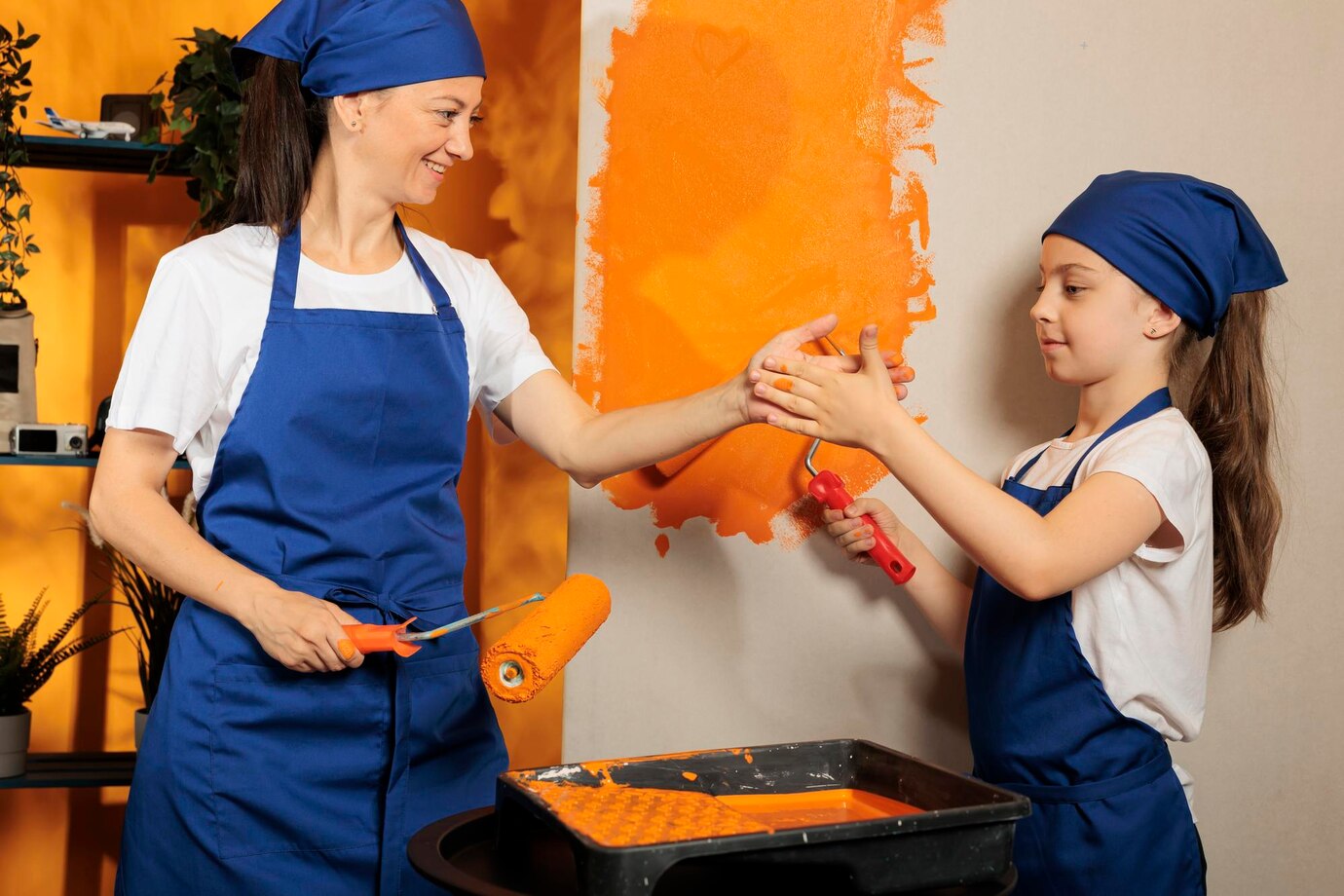If you’re considering remodelling a kitchen and ought to choose something lovely and natural in your circle of relative health and the surroundings, read on. Non-toxic kitchen paint has become increasingly famous with residence proprietors, who prioritise fitness and the environment. Traditional paints often include risky natural compounds (VOCs) that can launch risky chemical substances into the air, posing a chance to human health and the planet. Contrastingly, non-toxic styles are produced if you need to reduce or remove carbon emissions, making them a realistic preference for environmentally conscious families and people. Let’s explore the advantages of non-poisonous kitchen paint, from health advantages to eco-friendliness.

The Health Benefits of Non-Toxic Paint
The kitchen is the coronary heart of each day life in our houses. It’s where we prepare dinner, eat, and organise, making it important to ensure this space is lovely and secure. Traditional paints can be a hidden risk in our kitchens, emitting harmful chemicals that degrade indoor air and pose fitness dangers. That’s where non-toxic kitchen paint is available—a more fit, smarter choice for your private home.
Breathe Easy with Improved Indoor Air Quality
Traditional paints are often loaded with risky natural compounds (VOCs). These chemical compounds can emit gasoline into the air long after the paint has dried, leading to terrible indoor air conditions. VOCs were connected to a variety of health problems, from complications and dizziness to greater critical lengthy-term results like breathing troubles and even cancer. Switching to non-toxic paint eliminates this risk, permitting you to respire simply knowing your kitchen air is loose from these harmful pollutants.
Create a Healthier Home Environment
Our kitchens are bustling hubs wherein we spend a wide amount of time. VOCs and other toxic chemicals in traditional paints may be mainly regarded in those regularly used spaces. Non-toxic paints are formulated without these harmful substances, presenting more secure surroundings for you and your circle of relatives. Especially when you have young youngsters, an elderly circle of relatives, participants, or pets, selecting non-poisonous paint can considerably lessen their publicity to potentially dangerous chemical substances.
Comfort for People with Allergies and Asthma
VOCs might also moreover have even more pronounced effects on humans with allergic reactions. Non-toxic paints are designed to be hypoallergenic and loose from irritants that could cause hypersensitivity or bronchial allergy symptoms. This makes them a top-notch preference for growing a more comfortable and fitness-conscious dwelling area.
Supporting Overall Well-Being
Beyond the bodily health advantages, using non-toxic paints contributes to well-being. Knowing you’ve selected a more secure, more responsible option for your house can offer peace of mind and beautify your common quality of life. By matching your living area with your ideals, your decision demonstrates a dedication to your and your family’s health.
Eco-Friendly Advantages
Every decision you make while redesigning your kitchen impacts the surrounding area. Choosing non-toxic kitchen paint is a step toward a sustainable future, not just a gesture toward health. Let’s explore why this preference is so impactful.
Sustainable Ingredients
Non-poisonous paints are made from natural, sustainable components. Unlike traditional paints, which rely on synthetic chemical compounds and petroleum-based totally products, non-poisonous options frequently consist of plant oils, minerals, and water-primarily based solvents. These ingredients are safer for you and, notably, lessen the environmental footprint of your protection project. By selecting non-poisonous paint, you’re helping a cleaner, greener manufacturing method.
Reducing Carbon Footprint
Traditional paint production is a chief contributor to greenhouse fuel emissions. Synthetic paints’ extraction, refinement, and chemical processing release much carbon dioxide and other harmful pollution into the surroundings. Non-toxic paints are commonly produced using techniques that minimise those emissions. Some manufacturers even use renewable power resources throughout production. By opting for those eco-friendly paints, you’re reducing your renovation’s carbon footprint.
Minimising Waste
Conventional paint’s packaging and disposal also pose massive environmental challenges. Non-toxic paint manufacturers frequently use recyclable or biodegradable packaging, lowering landfill waste. Furthermore, leftover non-poisonous paint may be disposed of more competently than conventional paints, which regularly require particular dealing because of their unstable nature.
Helping to Promote a Circular Economy
With goods made to be recycled, repurposed, or reused at the end of their life cycles, many producers of non-toxic paint are part of an expanding trend toward a circular economy. This method encourages sustainability, limits waste, and protects natural resources. You are choosing to invest in a sustainable future and make an environmentally friendly decision by choosing non-toxic paint.
Fostering Biodiversity
Extracting raw materials for conventional paints frequently damages habitats and causes wildlife extinction. The environmental impact of non-poisonous paints is typically lower, especially when those paints are derived from natural sources. To help preserve biodiversity, these materials are gathered using methods that may be less harmful to ecosystems.
Supporting Eco-Conscious Brands
When you purchase non-toxic paint, you often guide corporations in prioritising environmental stewardship. These producers are commonly committed to sustainable practices, from sourcing uncooked materials to production and distribution. Your purchase allows fund innovation in eco-friendly products and practices, encouraging greater businesses to adopt similar processes.
Types of Non-Toxic Kitchen Paints
Choosing the right paint in your kitchen is not the colour; it is about creating a secure, sustainable desire that aligns with your values. Here, we delve into the various global non-toxic paints, breaking down the options so you can make a knowledgeable decision.
Natural Paints
Natural paints are exactly what they sound like—made from herbal substances. These encompass plant oils, clay, chalk, and herbal pigments. They’re free from synthetic chemical compounds, making them a tremendous preference for everyone trying to lessen their environmental footprint and avoid publicity of dangerous substances.
- Ingredients: Linseed oil, lime, clay, casein, herbal pigments.
- Benefits: Low environmental effect, biodegradable, minimum odour.
- Drawbacks: It may be pricier than conventional paints and require extra frequent contact-ups.
Low-VOC and Zero-VOC Paints
VOC stands for unstable natural compounds, chemical substances that can off-fuel into the air and contribute to indoor air pollutants. Low-VOC and 0-VOC paints are formulated to emit fewer or no VOCs, making them much more secure for indoor use.
- Ingredients: Water-based total solvents, herbal pigments, artificial resins (in low portions).
- Benefits: Better indoor air is excellent, with much less odour throughout the utility, and is extensively available.
- Drawbacks: Some manufacturers might include small amounts of VOCs; however, the colour range can be limited compared to traditional paints.
Milk Paint
Milk paint is one of the oldest varieties used for centuries before synthetic options appeared. Made from milk protein (casein), lime, and herbal pigments, it’s durable and environmentally pleasant.
- Ingredients: Milk protein, lime, clay, natural pigments.
- Benefits: Completely herbal, biodegradable, gives a unique, rustic end.
- Drawbacks: It should be combined before use and might have a shorter shelf life once prepared.
Clay Paint
Clay paint is another historical option, prized for its natural beauty and sustainability. It’s made from clay, minerals, and natural pigments and presents a fashionable, earthy matte finish.
- Ingredients: Clay, chalk, talc, herbal pigments.
- Benefits: Breathable, non-poisonous, natural humidity law.
- Drawbacks: It can be much less durable in regions with excessive visitors and typically requires a shielding sealant in kitchens.
Choosing the Right Paint for Your Kitchen
When selecting non-toxic paint for your kitchen, don’t forget factors like the degree of traffic in your kitchen, the preferred end, and your price range. Each sort of non-toxic paint has benefits and drawbacks, so weighing those cautiously is important.
- High-Traffic Areas: Opt for durable options like low-VOC or 0-VOC paints.
- Rustic Aesthetic: Milk or clay paint can provide that captivating, antique-international appearance.
- Eco-Friendly Focus: Natural paints are your go-to for the smallest environmental footprint.
Choosing the right paint for your kitchen is more than just a design selection—it is a commitment to health, sustainability, and beauty. Non-toxic kitchen paints offer many advantages beyond the floor, making them desirable for any renovation.

Schedule Your Consultation and Start Your Healthier Home Renovation Today
Transforming your private home into a more secure, more beautiful space begins with the proper alternatives. At Butler Bathrooms Ballarat, we concentrate on green, non-poisonous paints that enhance the health and aesthetic appeal of your kitchen, toilet, laundry, and whole home. Our expert group is here to guide you through the excellent alternatives tailored to your wishes, ensuring a sustainable and stunning result.
Ready to make a change? Speak to our specialists to discover how non-toxic paints can revolutionise house maintenance. Let’s collectively create a healthier, more colourful surrounding area.



